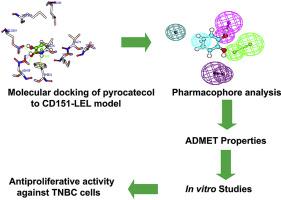Journal of Molecular Graphics and Modelling ( IF 2.9 ) Pub Date : 2020-07-22 , DOI: 10.1016/j.jmgm.2020.107681 Manasa Akella 1 , RamaRao Malla 1

|
CD151 has been recognized as a prognostic marker, the therapeutic target of breast cancers, but less explored for small molecule inhibitors due to lack of a validated model. The 3-D structure of CD151 large extracellular loop (LEL) was modeled using the LOMETS server and validated by the Ramachandran plot. The validated structure was employed for molecular docking and structure-based pharmacophore analysis. Druglikeness was evaluated by the ADMET description protocol. Antiproliferative activity was evaluated by MTT, BrdU incorporation, flow cytometry, and cell death ELISAPLUS assay. This study predicted the best model for CD151-LEL with 94.1% residues in favored regions and Z score −2.79 kcal/mol using the threading method. The web-based receptor cavity method identified one functional target site, which was suitable for the binding of aromatic and heterocyclic compounds. Molecular docking study identified pyrocatechol (PCL) and 5-fluorouracil (FU) as potential leads of CD151-LEL. The pharmacophore model identified interaction points of modeled CD151-LEL with PCL and FU. Also, the analysis of ADMET properties revealed the drug-likeness of PCL and FU. The viability of MDA-MB 231 cells was significantly reduced with PCL and FU but less affected MCF-12A, normal healthy breast epithelial cell line. With 50% toxic concentration, both PCL and FU significantly inhibited 82.46 and 87.12% proliferation, respectively, of MDA-MB 231 cells by altering morphology and inducing G1 cell cycle arrest and apoptosis. In addition, PCL and FU inhibited the CD151 expression by 4.5-and 4.8-folds, respectively. This study suggests the further assessment of pyrocatechol as a potential lead of CD151 in breast cancer at the molecular level.
中文翻译:

邻苯二酚作为CD151抑制剂的潜在药效基团的分子建模和体外研究。
CD151被公认为是乳腺癌的预后指标,是乳腺癌的治疗靶标,但由于缺乏经过验证的模型,对小分子抑制剂的研究较少。使用LOMETS服务器对CD151大细胞外环(LEL)的3-D结构进行了建模,并通过Ramachandran图进行了验证。经验证的结构用于分子对接和基于结构的药效团分析。通过ADMET描述方案评估药物相似性。通过MTT,BrdU掺入,流式细胞术和细胞死亡ELISA PLUS评估抗增殖活性分析。这项研究使用穿线方法预测了CD151-LEL的最佳模型,其在有利区域的残基为94.1%,Z评分为-2.79 kcal / mol。基于网络的受体腔法确定了一个功能性目标位点,该位点适用于芳香族和杂环化合物的结合。分子对接研究确定了邻苯二酚(PCL)和5-氟尿嘧啶(FU)是CD151-LEL的潜在先导。药效团模型确定了建模的CD151-LEL与PCL和FU的相互作用点。同样,对ADMET特性的分析揭示了PCL和FU的药物相似性。PCL和FU可以显着降低MDA-MB 231细胞的活力,但对MCF-12A(正常的健康乳腺上皮细胞系)的影响较小。毒性浓度为50%时,PCL和FU分别分别显着抑制82.46和87.12%的增殖,MDA-MB 231细胞通过改变形态并诱导G1细胞周期阻滞和凋亡而发生凋亡。此外,PCL和FU分别抑制CD151表达4.5倍和4.8倍。这项研究建议在分子水平上进一步评估邻苯二酚作为乳腺癌中CD151的潜在先导。



























 京公网安备 11010802027423号
京公网安备 11010802027423号